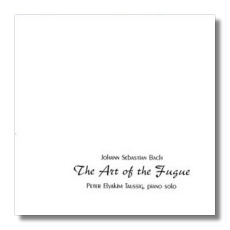
The Internet's Premier Classical Music Source
Related Links
- J.S. Bach Reviews
- Latest Reviews
- More Reviews
-
By Composer
-
Collections
DVD & Blu-ray
Books
Concert Reviews
Articles/Interviews
Software
Audio
Search Amazon
Recommended Links
Site News
 CD Review
CD Review
One-handed classical pianists are not unprecedented, and I've heard of at least one concert pianist who is missing two fingers. Peter Elyakim Taussig has them beaten: he is a pianist whose physical challenges have made it nearly impossible for him to play the piano at all. Nevertheless, he is an excellent musician and performer. How can this be?
Like many pianists, Taussig (born in Czechoslovakia, raised in Israel, active in Canada, and now a resident of the United States) got on the performer's merry-go-round of playing a concert in one city, getting on a plane, and playing a concert in the next city. So he went to a yoga retreat, liked it, and stayed there for five years. Refreshed, he readied himself for a return to performance, and then something bad happened. Crippling pain in his hands eventually was diagnosed as carpal tunnel syndrome and arthritis. He had difficulty performing basic manual tasks, let alone playing the piano.
Taussig took a few years off to do other things. Then, the opportunity to make a comeback of sorts was provided by Yamaha and its Disklavier PRO, an acoustic grand piano that can be "played" by a computer. Through a process he calls "musical sculpting," Taussig learned how to create music again by entering it one note, one phrase, and one line at a time on a computer. This raw material is then "sculpted" with a specialized mouse, allowing Taussig to shape the characteristics that make a mere note into music, including volume, articulation, and miniscule adjustments in tempo and timing.
In this manner, Taussig has recorded Bach's massive The Art of Fugue. (He's now working on The Well-Tempered Clavier.) To make the present CD, Taussig's sculpted performance was played by a Disklavier in New York City, and this performance was relayed by internet to a second Disklavier in a Los Angeles studio, where the actual recording was made. This probably is the only CD you'll ever hear in which the performance started on the East Coast, and the music came out on the West.
My fear with digital keyboards is that they usually give mechanical sounding performances. On Taussig's CD, however, you can't tell that the music isn't being directly produced by a fine pianist sitting in front of an equally fine concert grand piano. The clarity of Bach's contrapuntal textures certainly is enhanced by the sculpting technique, so this is a great way to learn and love Bach's score. The performance is attractive, informed, and free of gimmickry. I can't say that I always want to hear this music played on a piano. (Bach did not specify instrumentation for The Art of Fugue). I can't even say that when I want to hear it played on a piano, I always want to hear it played in this manner. Knowing that you are hearing a human performer introduces an element of risk, and risk is exciting, and, if I may be so bold, musical. Nevertheless, Taussig is onto something here. In essence, he's created a new way of playing the piano, and uncooperative fingers no longer need to be excluded from playing the most technically difficult works in the repertoire. Fortunately, computers that completely replicate human taste, discernment, and creativity have yet to be developed. When that happens, we all might be out of a job.
Kudos, then, to Taussig and his brave resourcefulness, and thanks for an Art of Fugue that can teach all of us something new about the music… and about the human spirit.
This CD is available from Amazon.com and from http://www.crystalmusic.com/taussig/.
Copyright © 2001, Raymond Tuttle



















